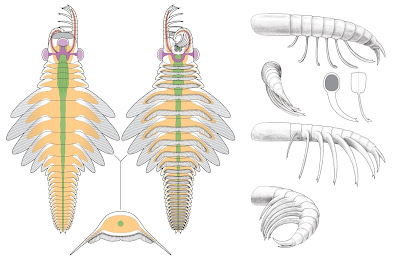 |
| Mosura fentoni Moysiuk & Caron, 2025 |
Abstract
Much diversity in arthropod form is the result of variation in the number and differentiation of segments (tagmosis). Fossil evidence to date has suggested that the earliest-diverging arthropods, the radiodonts, exhibited comparatively limited variability in tagmosis. We present a new radiodont, Mosura fentoni n. gen. and n. sp., from the Cambrian (Wuliuan) Burgess Shale that departs from this pattern. Mosura exhibits up to 26 trunk segments, the highest number reported for any radiodont, despite being among the smallest known. The head is short, with a small, rounded preocular sclerite, three prominent eyes and appendages with curving endites tipped with paired spines, altogether suggesting a nektonic, macrophagous predatory ecology. The trunk is divided into a neck, mesotrunk with large swimming flaps and multisegmented posterotrunk with tightly spaced bands of gill lamellae and reduced flaps. Detailed preservation of expansive circulatory lacunae, closely associated with the gills, clarifies the nature of similar structures in other Cambrian arthropod fossils, including Opabinia. The morphology of the posterotrunk suggests specialization for respiration, unique among radiodonts, but broadly convergent with the xiphosuran opisthosoma, isopod pleon and hexapod abdomen. This reinforces the hypothesis that multiple arthropod lineages underwent parallel diversification in tagmosis, in tandem with their initial Cambrian radiation.
Keywords: segmentation, convergence, Cambrian explosion, functional specialization, body plan, arthropod
Systematic palaeontology
Superphylum Panarthropoda Nielsen 1995
Phylum Arthropoda Gravenhorst 1843
Order Radiodonta Collins 1996
Family Hurdiidae Lerosey-Aubril & Pates 2018
Genus Mosura n. gen.
Type species: M. fentoni n. sp., by monotypy.
Etymology: From the name of the fictional Japanese monster, or kaiju モスラ (also known as ‘Mothra’), romanized according to Hepburn style, in reference to the moth-like appearance of the animal.
Mosura fentoni n. sp.
Holotype: ROMIP 67995, part and counterpart, a complete specimen preserved in dorsal view (figure 2a–d).
Etymology: In honour of Peter E. Fenton, for his 40 years of service as a technician in the Invertebrate Palaeontology section at the Royal Ontario Museum, and for his unwavering friendship to both authors.
Diagnosis: Radiodont with an adult trunk region divided into a four-segmented neck, six-segmented mesotrunk and up to 16-segmented posterotrunk. Flaps of mesotrunk up to ca 60% of core segment width. Flaps of posterotrunk markedly differentiated in size, less than ca 20% of core segment width. Caudal blades absent, posterotrunk terminating in pair of small, triangular processes. Appendages with six elongate endites (ca 3.5 times podomere height) with bifurcated tips. Lateral eye stalks short, less than eye diameter.
Joseph Moysiuk and Jean-Bernard Caron. 2025. Early Evolvability in Arthropod Tagmosis exemplified by A New Radiodont from the Burgess Shale. R. Soc. Open Sci. 12: 242122. DOI: doi.org/10.1098/rsos.242122 [14 May 2025]





